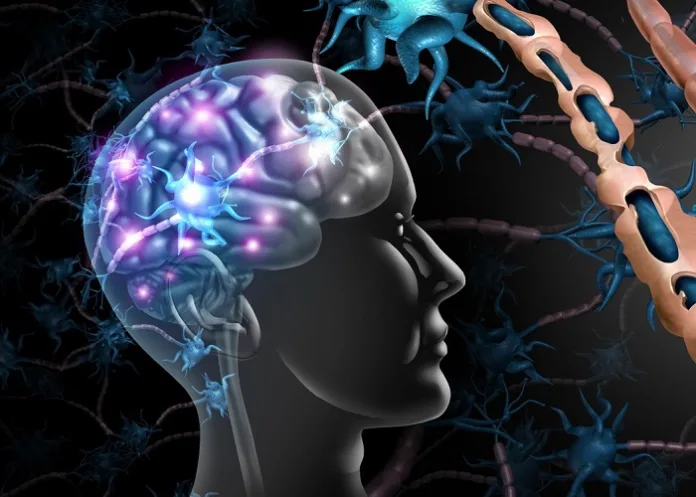The injection of a synthetic compound can highlight neurodegeneration in patients in the early stages of Parkinson’s disease – years before physical symptoms show – say Australian researchers.
The scientists at the Florey Institute and Austin Health in Melbourne have shown it is possible to detect early signs of the disease by injecting patients with 18F-AV-133, designed to bind to a protein in the brain known as VMAT2.
There is significant evidence that deficiency of VMAT2, an essential protein for neurotransmitter regulation, is linked to Parkinson’s disease, reports The Guardian.
The F-AV-133 compound becomes concentrated in areas of the brain where VMAT2 is active, with researchers then able to conduct a PET scan to capture images that show the strength and areas of VMAT2 activity, creating an imaging biomarker.
The researchers studied 26 patients with Parkinson’s disease, a control group of 12 people, and 11 people with Rapid Eye Movement (REM) sleep behaviour disorder, which is a significant indicator of Parkinson’s disease. Each person undertook two PET scans two years apart.
There were no significant changes in clinical symptoms in any of the participants according to currently available assessments for Parkinson’s disease, which involve asking people questions about their symptoms.
By contrast, the PET scans showed significant neuronal loss in three key regions of the brain in individuals with Parkinson’s disease, and in one key area of the brain in those with REM disorder, suggesting F-AV-133 is a more sensitive means of monitoring neurodegeneration.
The findings were published in the international journal Neurology.
Lead researcher Professor Kevin Barnham said Parkinson’s is often thought of as an illness of old age, when in fact it starts in midlife and can go undetected for decades.
“Parkinson’s disease is very hard to diagnose until symptoms are obvious, by which time, up to 85% of the brain’s neurons that control motor co-ordination have been destroyed,” he said.
“At that point, many treatments are likely to be ineffective. Our long-term goal is to find a way to detect the disease much earlier and treat people before the damage is done.”
He said further mathematical modelling conducted on the study data had found the imaging biomarker may be able to detect Parkinson’s disease up to 30 years before symptoms appear.
Degeneration happens in the brains of people with Parkinson’s before clinical diagnosis.
This is because there needs to be comprehensive loss of nerve cells that produce a chemical called dopamine before physical symptoms show, said Associate Prof Lyndsey Collins-Praino, a neurodegenerative diseases expert and senior lecturer in medicine with the University of Adelaide.
“So in recent years, there’s been a big push to try to identify what are called the prodromal symptoms of Parkinson’s, which are early warning signs and include things like reduction in the sense of smell, constipation, anxiety, and REM sleep behaviour disorder – the most predictive indicator,” she said.
She said the Parkinson’s field lags behind Alzheimer’s, which has much more extensively incorporated the use of biomarkers in research and testing. This is despite Parkinson’s being the fastest-growing neurological disease.
“In Parkinson’s, diagnosis is almost entirely based on subjective clinical judgment and to move forward, the field really does need to incorporate biomarkers,” Collins-Praino said.
Study details
Utilising 18F-AV-133 VMAT2 PET Imaging to Monitor Progressive Nigrostriatal Degeneration in Parkinson Disease
Leah Beauchamp, Vincent Dore, Victor Villemagne, SanSan Xu, David Finkelstein, Kevin Barnham, Christopher Rowe.
Published in Neurology on 10 October 2023
Abstract
Background
There are limited validated biomarkers in Parkinson’s disease (PD) which substantially hinders the ability to monitor disease progression and consequently measure the efficacy of disease-modifying treatments. Imaging biomarkers, such as VMAT2 PET, enable enhanced diagnostic accuracy, and detect early neurodegenerative changes associated with prodromal PD. This study sought to assess whether 18F-AV-133 VMAT2 PET is sensitive enough to monitor and quantify disease progression over a two-year window.
Methods
18F-AV-133 PET scans were performed on participants with PD and REM sleep behavior disorder (RBD) and neurological controls (NC). All participants were scanned twice ∼26 months apart. Regional tracer retention was calculated with a primary visual cortex reference region and expressed as the standard uptake volume ratio. Regions of interest included caudate, anterior and posterior putamen. At the time of scanning participants underwent clinical evaluation including UPDRSMOTOR test, Sniffin’ Sticks, and Hospital Anxiety and Depression Score.
Results
Over the 26-month interval a significant decline in PET signal was observed in all three regions in participants with PD (N=26) and in the posterior putamen in participants with RBD (N=11) compared to NC (N=12), consistent with a decrease in VMAT2 level and ongoing neurodegeneration. Imaging trajectory calculations suggest the neurodegeneration in PD occurs over ∼33 years [CI: 27.2, 39.5], with ∼10.5 years [CI: 9.1-11.3] of degeneration in the posterior putamen before it becomes detectable on a VMAT2 PET scan, a further ∼6.5 years [CI: 1.6,12.7] until symptom onset, and a further ∼3 years [CI: 0.3,8.7] until clinical diagnosis.
Discussion
Over a two-year period, F-AV-133 VMAT2 PET was able to detect progression of nigrostriatal degeneration in participants with PD and represents a sensitive tool to identify individuals at risk of progression to PD, which are currently lacking using clinical readouts. Trajectory models propose that there is nigrostriatal degeneration occurring for 20 years before clinical diagnosis. These data demonstrate that VMAT2 PET provides a sensitive measure to monitor neurodegenerative progression of PD which has implications for PD diagnostics and subsequently clinical trial patient stratification and monitoring.
See more from MedicalBrief archives:
Eye scans spot Parkinson’s risk seven years before symptoms
Visual dysfunction predicts Parkinson’s-linked cognitive decline 18 months ahead
Disrupted circadian rhythm associated with later Parkinson’s
Thousands of Parkinson’s patients initially misdiagnosed

